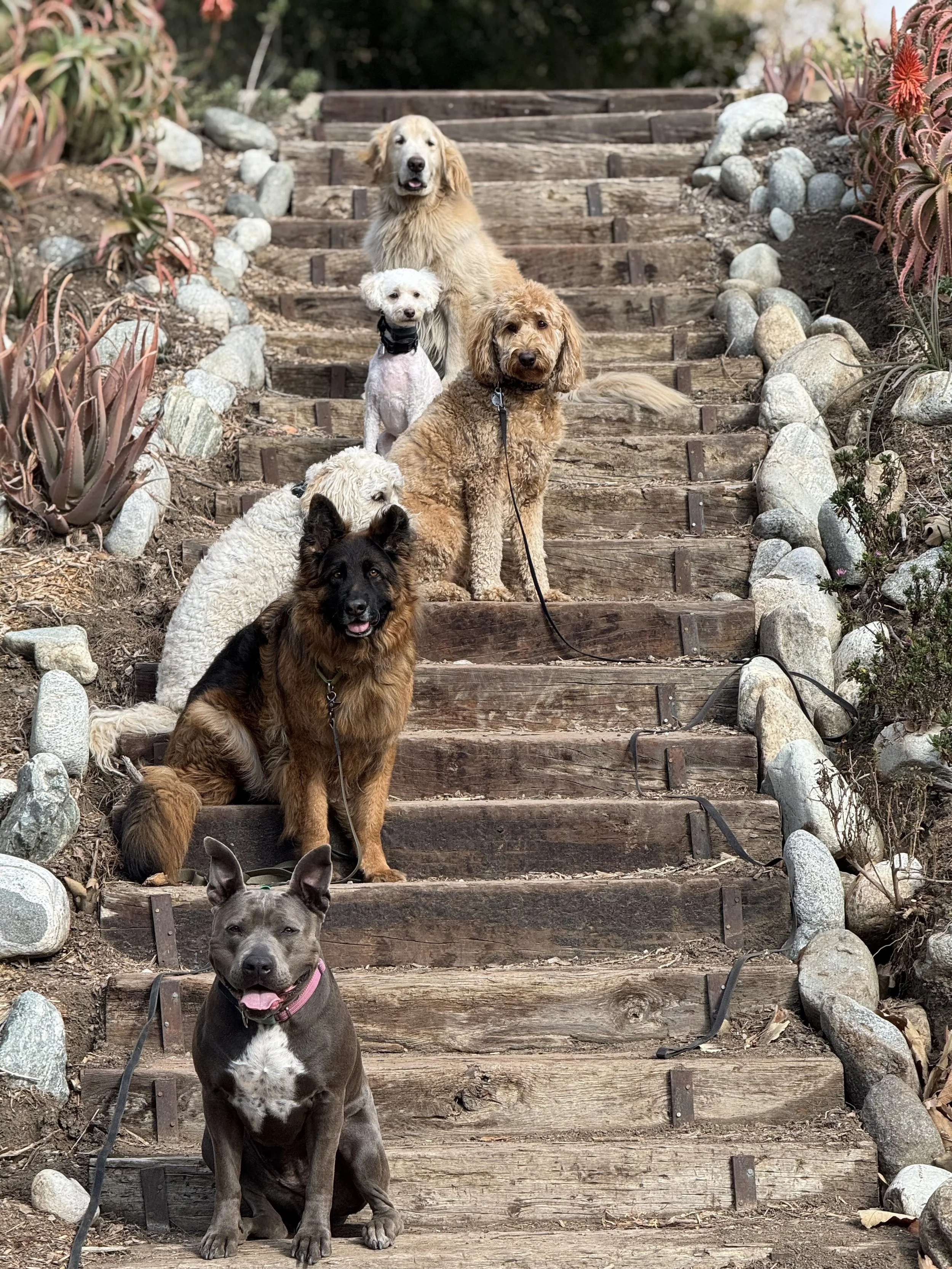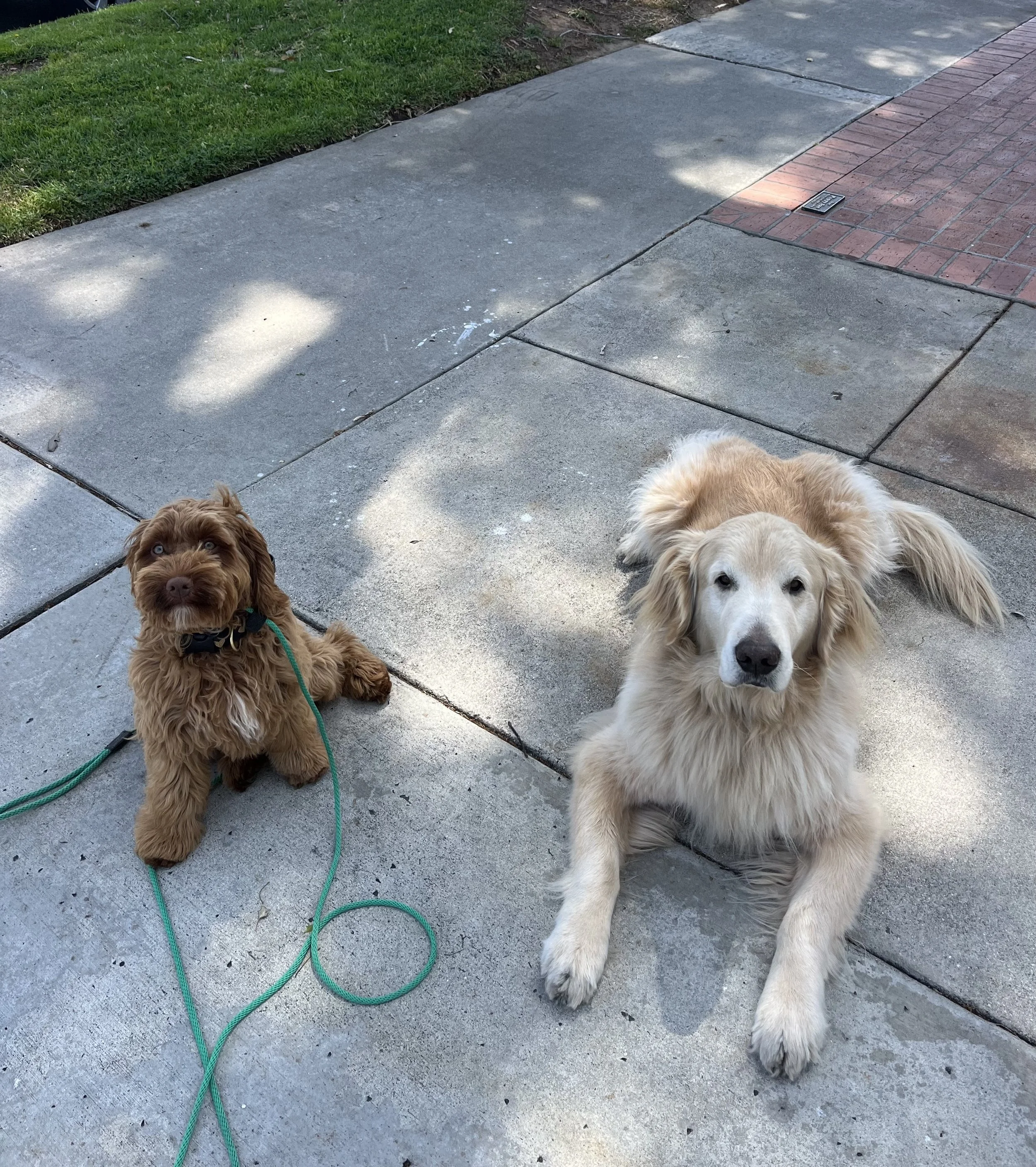Our FAQs
Can I train my dog to be less reactive and/or less aggressive?
A majority of the dogs that attend our classes have had a history of reactivity and/or aggression - here is a photo of our pups coexisting during a Saturday Huntington Beach group class.
The reactivity and/or aggression from our dogs is usually a result of fear or anxiety. A lack of confidence around people, dogs, cars, loud noises, etc. - that lead our dogs to default to defensive instincts. In cases of social reactivity, we may see the neighboring dogs walk by us on the street, while our dog is lunging towards them to play. Though the ladder is a more light-hearted situation, it displays the same confusion and disturbance to our order.
With obedience training, we work to build your dog’s confidence by labeling the handler as the leader of the pack. Our goal is to develop a clear chain of command in our dog/human relationship - mom or dad is in charge right now, so follow their lead. If you ask for a “sit”, your dog must sit. If you ask for a “come”, your dog must come.
Our approach will not be to rid them of their reactivity, but rather get them to pay attention to us. Which in turn, better shapes how they will react around disturbances in the future.
Working through these distractions and triggers from a training stand point, allows us to:
Regain our dog’s focus
Sharpen our obedience skills
Control the exposure to stress
Only after we have practiced using the equipment and our dogs have displayed an understanding of commands, will we begin to expose reactive and aggressive dogs to their respective triggers.
It is vital that they have an understanding of the tools (e-collar, leash pressure, rewards, etc.), prior to incorporating these distractions - as this allows them to see the correct response/positioning/outcome to each command before adding more disturbance to our environment.
We will begin by working around small distractions (treats, toys, inviting body language). Then we will aim to increase the environmental stimulation (dogs, people, doorbells, etc.).
We set ourselves and our dogs up for success by working slowly, safely, and deliberately. Ensure that you know the equipment, ensure that they know the commands, then begin to add the appropriate distractions and regain/maintain their attention via obedience training.
How old should my dog be to start training?
Hula Pie (left) is about 6 months old, we started training at 3.5 months.
Seamus (right) is 7 years old, we started training at 5 years.
Old dogs can learn new tricks. New dogs can learn new tricks. Our training style is suitable for all dog breeds over 5 months of age.
Prior to 5 months, simplified puppy training will take place. This is where we will use treats to shape behaviors and get our puppies familiar with commands (sit, down, place, come, etc.). Puppy training is very important - it will help to establish a sense of structure early on. Potty training, play biting, and obedience are some of the many aspects of owning a puppy that we want to get ahead of.
Around the 5 month mark, we begin to introduce the e-collar. After some time for the puppy to develop, the 5 month mark opens the fertile grounds for the puppy’s evolving mind to expand past simple treat training. With the appropriate care and intention, we begin to teach the puppy the ins and outs of our moving world - building trust and freedom in the process.
Are e-collars bad? Do they hurt my dog?
In short - it is only perceived as bad, if we introduce it as bad. Like any other tool (i.e. leash, clicker, prong collar), the appropriate use of the e-collar is going to ensure a positive experience for both you and your pup. This means the use of fair levels on the collar/remote, the correct fitting of the collar, and the proper expectations from the handler.
It is our goal to create a healthy relationship between the dog, the handler, and the e-collar. We do this by wearing the equipment frequently and using it appropriately.
We train with the e-collar to communicate with our dogs, not to punish them. To effectively communicate with our dogs, we use levels of stimulation that gain their attention as we seek a specific behavior (i.e. recall, sit, place, etc.). This means that we are teaching them to pay attention to their handler. Once we build their comprehension of the stimulation, we move forward in training - learning new commands, increasing distractions, etc.
Our list of approved e-collars include only those with clear, adjustable levels of stimulation - to ensure our pups do not experience inappropriate or unfair pressure while training. The approved e-collars are incapable of producing heat. They are also waterproof - to guarantee the elements do not affect the health and safety of our pups during outdoor training. All clients will get the chance to feel the stimulation from the collar during our initial consultation. This ensures that you understand the various levels of the equipment and have a strong idea of what your pup will feel during training. You will feel that the e-collar does not produce a shock - but rather a small stimulation to your muscles, that similar to the technology of a TENS unit.


